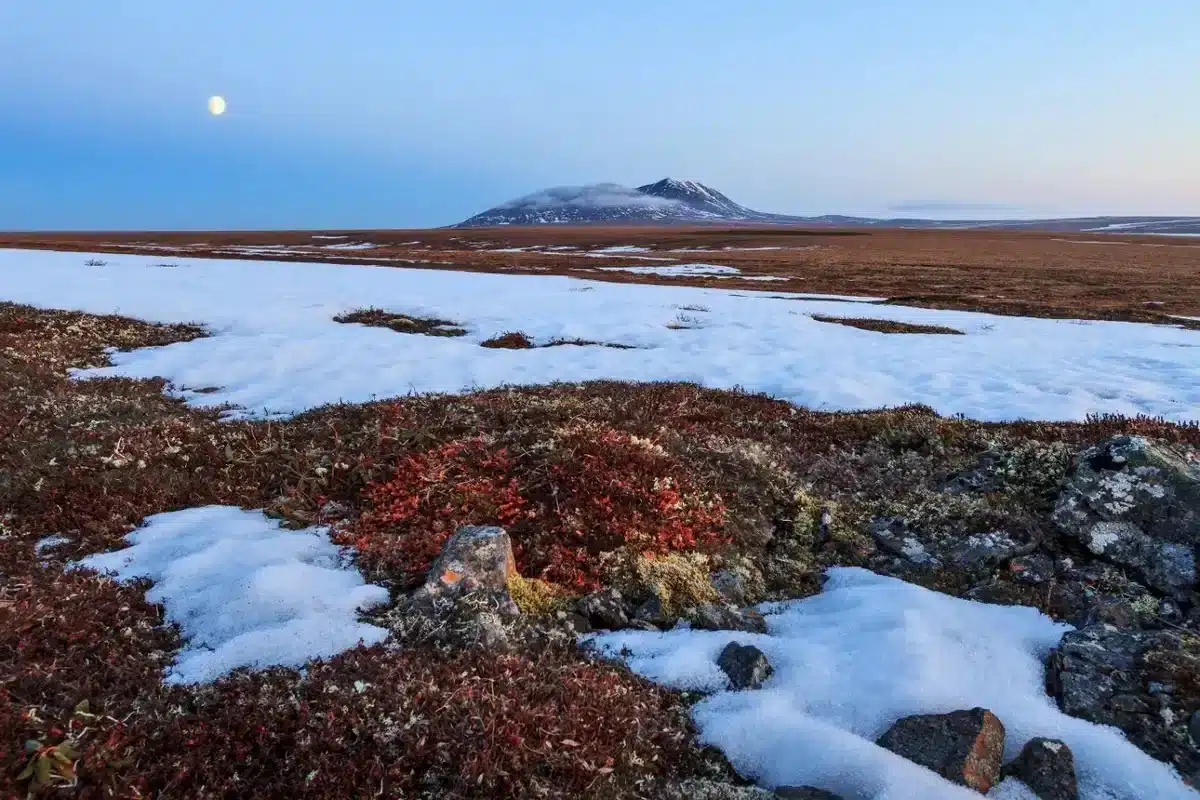About Arctic Tundra
- The Arctic Tundra is a vast, treeless biome characterized by its cold, dry, and rocky terrain.
- The term “tundra” originates from the Finnish word tunturi, meaning a ‘treeless plain.’
Characteristics of the Arctic Tundra
- Permafrost: It refers to permanently frozen soil, starting within a meter of the surface. During summer, only the upper layer thaws, while deeper layers remain frozen.
- The frozen layer restricts plant root growth and prevents tree growth, resulting in a treeless landscape.
- Soil composition: The tundra’s soil is rocky and nutrient-poor due to low decomposition rates.
- Organic material accumulates in the form of peat (decayed sphagnum moss) and humus (organic matter), making it a significant carbon sink.
- Geographic location: The Arctic tundra is the northernmost biome, covering areas north of the Arctic Circle up to the polar ice cap, parts of Canada, Iceland, and Greenland.
- It spans approximately 11.5 million km².
- Climate: Temperatures range from 15.5°C in summer to -60°C in winter, with mean temperatures below 0°C for 6–10 months.
- Annual precipitation is low, ranging between 150–250 mm, but evaporation is minimal.
- Features 24-hour sunlight in summer and 24-hour darkness in winter.
- Natural vegetation: Vegetation is predominantly herbaceous due to the cold climate and short growing season. Includes grasses, mosses (e.g., reindeer moss), lichens, and liverworts.
- Woody plants like dwarf willows remain short and spread to withstand high winds.
- Animal life: Large mammals such as polar bears, caribou, musk ox, and Arctic foxes inhabit the tundra.
- Smaller animals like lemmings and Arctic hares adapt with fur that changes colour seasonally.
- Migratory birds, such as loons and snow geese, breed in the tundra during summer.
- Arctic Tundra as a Carbon Sink: Despite the absence of trees, the Arctic Tundra is a significant carbon sink.
- This is due to the accumulation of organic matter in: Peat (Decayed sphagnum moss) and Humus (Decomposed organic material).
- The cold conditions slow decomposition, trapping carbon in the permafrost for millennia.
Reasons for Emissions:
- Thawing permafrost: Rising temperatures activate microbes, breaking down organic matter and releasing CO₂ and CH₄ (methane).
- Methane is a more potent greenhouse gas than CO₂.
- Increased wildfires: Release additional GHGs and Accelerate permafrost thawing.
- Temperature trends: The Arctic is warming four times faster than the global average. 2024 marked the second-warmest year since records began in 1900.
- Global carbon trends:
- CO2 emissions in 2024 are projected to be 41.6 billion tonnes, up from 40.6 billion tonnes in 2023.
- Land-use changes add 4.2 billion tonnes of emissions annually.
Q1. What is the Arctic Council?
The Arctic Council is an intergovernmental forum focused on addressing and discussing matters related to the Arctic region. Its key areas of work include scientific research, promoting peaceful cooperation, and ensuring the sustainable use of resources in the Arctic. The Council was established in 1996 through the Ottawa Declaration by the eight Arctic States.
Last updated on June, 2025
→ UPSC Notification 2025 was released on 22nd January 2025.
→ UPSC Prelims Result 2025 is out now for the CSE held on 25 May 2025.
→ UPSC Prelims Question Paper 2025 and Unofficial Prelims Answer Key 2025 are available now.
→ UPSC Calendar 2026 is released on 15th May, 2025.
→ The UPSC Vacancy 2025 were released 1129, out of which 979 were for UPSC CSE and remaining 150 are for UPSC IFoS.
→ UPSC Mains 2025 will be conducted on 22nd August 2025.
→ UPSC Prelims 2026 will be conducted on 24th May, 2026 & UPSC Mains 2026 will be conducted on 21st August 2026.
→ The UPSC Selection Process is of 3 stages-Prelims, Mains and Interview.
→ UPSC Result 2024 is released with latest UPSC Marksheet 2024. Check Now!
→ UPSC Toppers List 2024 is released now. Shakti Dubey is UPSC AIR 1 2024 Topper.
→ Also check Best IAS Coaching in Delhi
























